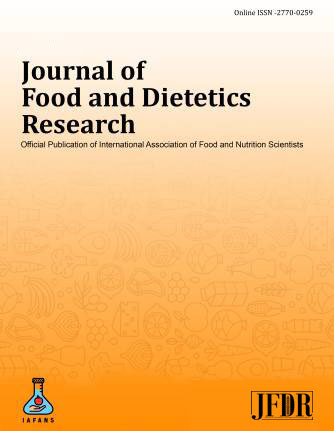Correlation of Body composition, Physical activity with aging: a cross-sectional study for urban adult Indian women
DOI:
https://doi.org/10.48165/jfdr.2022.3.3.2Keywords:
Body composition, Physical activity, Ageing, BMI, GPAQAbstract
With simple random sampling technique for 450 women of age group 41-55 years, with the general objective of finding out the relationship between Body composition, Physical activity with aging in Gwalior city of India ,descriptive cross-sectional study was conducted . The group was further subdivided into three age groups of 41-45, 46-50, and 51-55 years. Hypothesis testing F test and Correlation were applied to analyze the data.There was significant difference in Body fat percentage score across the three subgroups (p = 0.030). The high mean body mass index (BMI-27.31 (±4.8)) for the total population is an alarming indication for the increasing overweight population in India. The same was supported by a higher average waist-hip ratio of 0.87. The mean weight of 450 women was 65.3 kg (±11.5).GPAQ score differed significantly across the three age groups (p = 0.000).With very high contribution in GPAQ score from house works, majority of the women were found moderately physically active and Sports, fitness and recreational activities were found very less. The older age group was found less physically active. The Findings were that body fat% were positively correlated (p<0.000)and GPAQ score were negatively correlated (p< 0.000) with ageing . The average body age of the study population for Adult women was observed 56 (± 9.9) years against the actual chronological average age of 47.7 years (±4.8), which is around 8 years more. Results emphasized the need for more physical activity for adult women from sports, fitness, and recreational activities in addition to housework for maintaining their body composition and to avoid early aging.
Downloads
References
United Nations Department of economic and social affairs 2008. https://www.who.int/india/health-topics/ageing
Muller, D C., Elahi, D., Sorkin, J. D. & Andres, R. (1995) Muscle mass: it’s measurement and influence on aging: the Baltimore Longitudinal Study of Aging. Rosenberg, I.H. eds. Nutritional Assessment of Elderly Populations Measure and Function: 50–62 Raven Press New York.
Borkan, G. A. & Norris, A H. (1977) fat redistribution, and the changing body dimensions of the adult male Human Biol 49:495–513.
Morley, J. E. (1997) Anorexia of aging: physiolic and pathologic. Am. J. Clin. Nutr 66:760– 773
Driskell J.A nutrition and exercise concern’s of middle age. United States of America : CRC Press (2009).
United Nations, Department of Economic and Social Affairs, Population Division (2017) : World Population Ageing 2017.
J Public Health Res. 2020 Jul 3; 9(2): 1840. Effect of age and weight on physical activity
Takagi D, Nishida Y Fujita D. Age-associated changes in the level of physical activity in elderly adults. J Phys Ther Sci. 2015; 27:3685-7, Varma VR, Dey D, Leroux A, et al. Re-evaluating the effect of age on physical activity over the lifespan. Prev Med 2017; 101:102–8).
J. D. Stookey L. Adair, J. Steven and B. M. Popkin, “Patterns of Long Term Change in Body Composition Are Associated with Diet, Activity, Income and Urban Residence among Older Adults in China,” The Journal of Nutrition, Vol. 131, No. 9, 2001, pp. 2433-24.
Tampubolon G. Trajectories of the healthy ageing pheno type among middle aged and older Britons: 2004–2013. Maturitas 2016; 88:9-15. https://doi.org/10.1016/j.maturi tas.2016.03.002
Daskalopoulou C, Koukounari A, Wu YT, Terrera GM, Caballero FF, de la Fuente J, et al. Healthy ageing trajectories, and lifestyle behavior: the Mexican health and aging study. Scientific Reports 2019; 9:11041. https://doi.org/10.1038/
s41598-019-47238-w
World Health Organization: Global action plan for the preven tion and control of non communicable diseases 2013-2020. 31 May 2013 Geneva, WHO-2013 www.who.int/publica tions/i/item/9789241506236
https://www.worldwidejournals.com/paripex/article/modi fied-kuppuswamy-scale -updated-for-year- 2018
D. B. Joliffe (1966), “The Assessment of Nutritional Status of Community,” WHO, Geneva, 1966
World Health Organization Geneva(2003, p. 149 p).WHO tech nical report series no. 916: Joint WHO/FAO expert consul tation: diet, nutrition and the prevention of chronic diseases.
https://www.who.int/teams/noncommunicable-diseases/sur veillance/systems-tools/physical-activity-surveillance World Health Organization, Geneva (1995), Physical status: the use and interpretation of anthropometry, Report of WHO expert committee, technical report series 854
World Health Organization, Geneva (2000) Obesity: preventing and managing the global epidemic. Report of WHO consul tation, WHO technical report series 894
Health Communications Australia: Melbourne, (2000). The Asia Pacific perspective: redefining obesity and its treatment. WHO Expert Consultation: Appropriate body-mass index for Asian populations and its implications for policy and inter vention strategies Lancet. (2004 Jan) 10; 363(9403):157-63. doi: 10.1016/S0140-6736(03)15268-3. Erratum in: Lancet. 2004 Mar 13; 363(9412):902. PMID: 14726171.
Lohman, T.G. (1986), Applicability of body composition tech niques and constants for children and youths. In Exercise and Sport Sciences Reviews, ed. KB Pandolf, pp 325–357. New York: Macmillan
Https: //eprints.qut.edu.au/12749/1/12749, Wilmore, J. H., Buskirk, E. R., DiGirolamo, M., &Lohman, T. G. (1986). Body composition a round table: The Physician and sports medicine, 14, 144-162.
Https://eprints.qut.edu.au/12749/1/12749, Nagamine, S. (1972). Hikashiboukara no himan no hantei [Jap], Nihon IshikaiZasshi, 68, 919-924.
https://www.omronhealthcareap.com/Content/uploads/prod ucts/789b8222779742fe808151a86d9851e4.pdf
https://www.omronhealthcareap.com/Content/uploads/prod ucts/789b8222779742fe808151a86d9851e4.pdf
G. Kaur, K. Bains and H. Kaur (2012), “Body Composition, Dietary Intake and Physical Activity Level of Sedentary Adult Indian Women,” Food and Nutrition Sciences, Vol. 3 No. 11, 2012, pp. 1577-1585. doi: 10.4236/
fns.2012.311206.
Rao BB, Junapudi SS (2019): A comparative study of preva lence of overweight and obesity among urban, and rural
population of South India. Int J Community Med Public Health 2019; 6: 1091-5.
Tiwari R, Srivastava D, Gour N (2009): A cross-sectional study to determine Prevalence of Obesity in High Income Group Colonies of Gwalior City. Indian J Community Med. 2009 Jul; 34(3):218-22.
G. Kaur, K. Bains and H. Kaur, “Body Composition, Dietary Intake and Physical Activity Level of Sedentary Adult Indian Women,” Food and Nutrition Sciences, Vol. 3 No. 11, 2012, pp. 1577-1585. doi: 10.4236/fns.2012.311206.
Janssen , S B Heymsfield, Z M Wang, R Ross Skeletal muscle mass and distribution in 468 men and women aged 18-88 year, J ApplPhysiol (1985). 2000 Jul; 89(1):81-8. doi: 10.1152/ jappl.2000.89.1.81.




